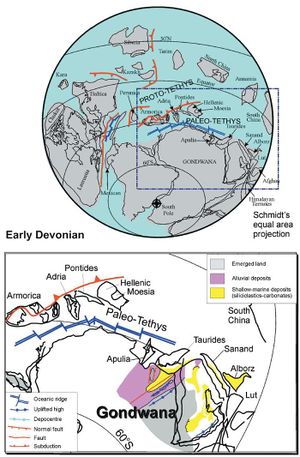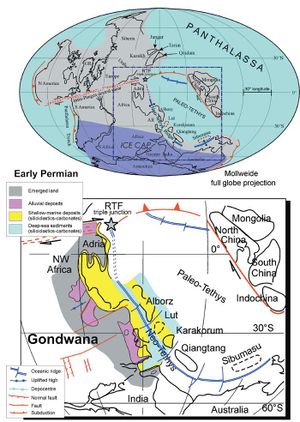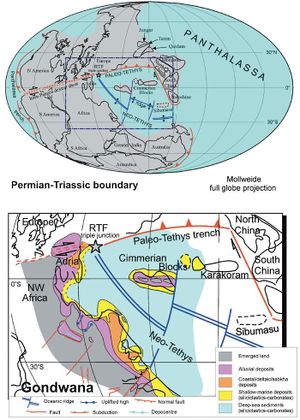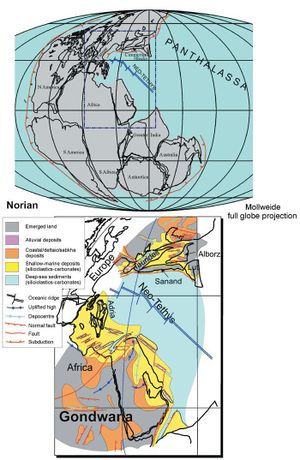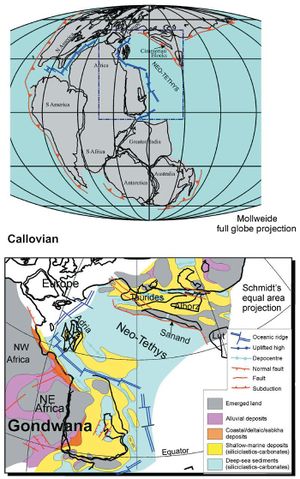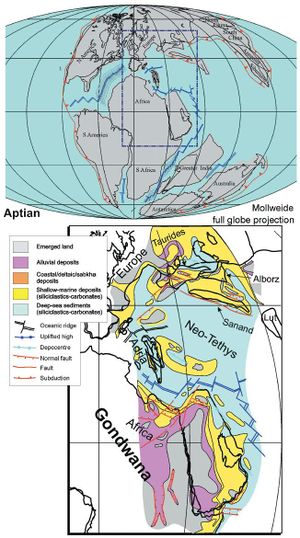Difference between revisions of "Phanerozoic Tethys region"
| Line 67: | Line 67: | ||
Garzanti, E., 1999, Stratigraphy and sedimentary history of the Nepal Tethys Himalayan passive margin, in B. N. Upreti and P. Le Fort, eds., Advances on the geology of the Himalaya - focus on Nepal: Journal of Asian Earth Sciences, v. 17, p. 805–827.</ref> <ref name=Angiolinietal_2003>Angiolini, L., Balini, M., Garzanti, E., Nicora, A., and Tintori, A., 2003, Gondwanan deglaciation and opening of Neotethys: Palaeontological and sedimentological evidence from interior Oman: Palaeogeography, Palaeoclimatology, Palaeoecology, v. 196, p. 99–123.</ref> <ref name=Metcalfe_2006 />). In the same time interval, a major zone of northward subduction of Paleotethyan oceanic crust was active along the Eurasian margin and persisted through most of Permian–Triassic times (e.g., Dercourt et al.,<ref name=Dercourtetal_1993 /> Alavi et al.,<ref name=Alavital_1997>Alavi, M., Vaziri, H., Seyed Enami, K., and Lasemi, Y., 1997, The Triassic and associated rocks of the Nakhlak and Aghdarband areas in central and northeastern Iran as remnants of the southern Turanian active continental margin: GSA Bulletin, v. 109, p. 1563–1575.</ref> Besse et al.,<ref name=Besseetal_1998 /> Metcalfe<ref name=Metcalfe_2006 />). Transpressive strike-slip tectonics was responsible for basin inversion in Lybia and Egypt.<ref name=Schandelmeierandreynolds_1997 /> | Garzanti, E., 1999, Stratigraphy and sedimentary history of the Nepal Tethys Himalayan passive margin, in B. N. Upreti and P. Le Fort, eds., Advances on the geology of the Himalaya - focus on Nepal: Journal of Asian Earth Sciences, v. 17, p. 805–827.</ref> <ref name=Angiolinietal_2003>Angiolini, L., Balini, M., Garzanti, E., Nicora, A., and Tintori, A., 2003, Gondwanan deglaciation and opening of Neotethys: Palaeontological and sedimentological evidence from interior Oman: Palaeogeography, Palaeoclimatology, Palaeoecology, v. 196, p. 99–123.</ref> <ref name=Metcalfe_2006 />). In the same time interval, a major zone of northward subduction of Paleotethyan oceanic crust was active along the Eurasian margin and persisted through most of Permian–Triassic times (e.g., Dercourt et al.,<ref name=Dercourtetal_1993 /> Alavi et al.,<ref name=Alavital_1997>Alavi, M., Vaziri, H., Seyed Enami, K., and Lasemi, Y., 1997, The Triassic and associated rocks of the Nakhlak and Aghdarband areas in central and northeastern Iran as remnants of the southern Turanian active continental margin: GSA Bulletin, v. 109, p. 1563–1575.</ref> Besse et al.,<ref name=Besseetal_1998 /> Metcalfe<ref name=Metcalfe_2006 />). Transpressive strike-slip tectonics was responsible for basin inversion in Lybia and Egypt.<ref name=Schandelmeierandreynolds_1997 /> | ||
| − | In Pennsylvanian–Early Permian times, an extensive glaciation affected much of Gondwana (e.g., Stephenson et al.,<ref name=Stephensonetal_2007 /> Frank et al.<ref name=Franketal_2008 />), leaving widespread glacial deposits at high to intermediate southern latitudes. The tropical belt was thus restricted to very low latitudes, which benefited from a warm westward-flowing equatorial current, which, upon reaching the continental shelves of the western Tethys Gulf, deflected southeastward, bringing warm surface waters toward the northern corner of Arabia.<ref name=Angiolinietal_2007 /> This compressed tropical current gyre was bounded to the south by the thermal effects of the Gondwanan glacial climate, which directly controlled the distribution of cold biota in most other peri-Gondwanan terranes. | + | In Pennsylvanian–Early Permian times, an extensive glaciation affected much of Gondwana (e.g., Stephenson et al.,<ref name=Stephensonetal_2007>Stephenson, M. H., Angiolini, L., and Leng, M. J., 2007, The Early Permian fossil record of Gondwana and its relationship to deglaciation: A review, in M. Williams, A. Haywood, J. Gregory, and D. Schmidt, eds., Deep time perspectives on climate change: Marrying the signal from computer models and biological proxies: London, Publication of The Micropalaeontological Society, Special Publications. GSL p. 103–122.</ref> Frank et al.<ref name=Franketal_2008>Frank, T. D., Birgenheier, L. P., Montañez, I. P., Fielding, C. R., and Rygel, M. C., 2008, Late Paleozoic climate dynamics revealed by comparison of ice-proximal stratigraphic and ice-distal isotopic records, in C. R. Fielding, T. D. Frank, and J. L. Isbell, eds., Resolving the late Paleozoic Ice Age in time and space: GSA Special Paper 441, p. 331–342.</ref>), leaving widespread glacial deposits at high to intermediate southern latitudes. The tropical belt was thus restricted to very low latitudes, which benefited from a warm westward-flowing equatorial current, which, upon reaching the continental shelves of the western Tethys Gulf, deflected southeastward, bringing warm surface waters toward the northern corner of Arabia.<ref name=Angiolinietal_2007 /> This compressed tropical current gyre was bounded to the south by the thermal effects of the Gondwanan glacial climate, which directly controlled the distribution of cold biota in most other peri-Gondwanan terranes. |
| + | |||
| + | [[file:M106Ch01Fig06.jpg|thumb|300px|{{figure number|6}}Global paleogeography (top) and major depositional settings in the southern margin of the Tethys (below) at the time of the Permian-Triassic boundary (about 251 Ma).]] | ||
| + | |||
| + | ===Permian-Triassic Boundary (251 Ma)=== | ||
| + | The beginning of the Mesozoic was marked by the end of the transitional stage from the Pangea B to Pangea A configurations (Irving, 1977; Morel and Irving, 1981; Muttoni et al., 1996; Torq et al., 1997; Bachtadse et al., 2002; Irving, 2005; Angiolini et al., 2007). The change in the configuration of Pangea required a west to east translation of Laurasia of some 3000 km (1864 mi) with respect to Gondwana (Figure 6). The dextral movement was accommodated along a lithospheric shear zone which runs from the subduction zone of Panthalassa eastward to a triple junction joining this shear zone, the Neo-Tethys ridge, and the subduction of Paleo-Tethys below the southern margin of Laurasia. This triple junction was located along the northern margin of the Tethys, close to southern Europe (Muttoni et al., 2009b). | ||
| + | |||
| + | Northern Gondwana was characterized by the development of a mature passive margin along the Neo-Tethys Ocean, which started to open with a time-transgressive trend beginning in Carboniferous time (Al-Belushi et al., 1996; Garzanti and Sciunnach, 1997). Oceanic crust began forming as early as Early Permian time (Garzanti, 1999; Angiolini et al., 2003; Metcalfe 2006). The opening of the Neo-Tethys was responsible for the northward flight of the peri-Gondwanan blocks: in Early Triassic time these continental blocks were moving northward toward the southern margin of Asia. These blocks include a number of minor, semi-independent blocks such as Apulia, Taurides, Iran (NW and Central), Sanandaj Sirjian, Heland, and Northern Tibet (Ruban et al., 2007). In detail, Iran was crossing the equator (Muttoni et al., 2009b) before its docking to Eurasia, which gave rise to the Cimmerian orogeny. In contrast, to the east most of the blocks were still located south of the equator. The different velocities of the peri-Gondwanan blocks were probably controlled by the presence of roughly N-S trending transform faults, which defined portions of the Neo-Tethys oceanic ridge characterized by different rates of spreading. The existence of a complex network of oceanic branches during the opening of the Neo-Tethys has been suggested by Sengor (1990), who interpreted the peri-Gondwanan blocks as three independent ribbons migrating northward. | ||
| + | |||
| + | The present-day North Africa was located along the southern passive margin of Neo-Tethys and was characterized by the development of extensional basins in Lybia and Levant (probably transtensional basins; Schandelmeier and Reynolds, 1997). Paleogeographic reconstructions are more complex in the western part of the Tethys, as the narrowing of the oceanic basin along with the closer proximity of the Neo-Tethys ridge and the Paleo-Tethys subduction zone complicate the definition and precise position of the numerous blocks which can be identified in this zone. Furthermore, the position and significance of blocks such as the Taurides and Apulia are still a matter of debate. Paleogeographic reconstructions in the western part of the Tethys Ocean are often contrasting (e.g., Dercourt et al., 2000; Stampfli and Borel, 2002). Differences can be ascribed to the puzzle of small plates and to the complex history of aperture and closure of small oceanic branches which characterize, for most of the Mesozoic, the Alpine and Dinaric domains. There are also different interpretations of the significance of the multiple extensional events along northern Gondwana, which is the most likely to represent breakup and formation of the passive margin at any particular location. | ||
| + | |||
| + | The Permian-Triassic boundary was characterized at a global scale by low sea level, reflected by widespread continental or shallow marine facies. The beginning of Triassic time was characterized by a sea-level rise that can be traced worldwide. | ||
| + | |||
| + | The end Permian crisis is generally considered the most dramatic extinction of the last 600 million years (Erwin, 2006) and led to the extinction of 75–96% of species. Some of the invoked mechanisms included rapid sea-level change and/or anoxia or euxinia (e.g., Wignall and Twitchett, 2002; Hays et al., 2007); extraterrestrial impact (e.g., Becker et al., 2001); enormous volcanic eruptions and/or an extreme global warming (e.g., Kidder and Worsley, 2004; Svensen et al., 2008; Reichow et al., 2009); or ozone layer collapse (e.g., Beerling et al., 2007). The pattern of the latest Permian extinction evaluated statistically (Jin et al., 2000; Shen et al., 2006; Groves et al., 2007; Angiolini et al., 2010) indicates that the extinction was a sudden event occurring during a sea-level rise. The evidence that the extinction was abrupt in different latest Permian paleogeographic settings is consistent with scenarios in which mass extinction resulted from climatic and environmental deterioration triggered by the Siberian Traps volcanism, which also increased greenhouse gas emissions into the atmosphere and thus global warming and ozone depletion. This is also supported by the pronounced negative δ13C excursion recorded worldwide near the latest Permian extinction event (e.g., Baud et al., 1989; Retallack and Krull, 2006; Horacek et al., 2007). | ||
| + | |||
| + | [[file:M106Ch01Fig07.jpg|thumb|300px|{{figure number|7}}Global paleogeography (top) and major depositional settings in the southern margin of the Tethys (below) during Norian time (about 205 Ma).]] | ||
| + | |||
| + | ===Norian (about 205 Ma)=== | ||
| + | The Norian represents a key interval in the evolution of the Paleo-Tethys Ocean (Figure 7). During this stage the first evidence for the closure of the Paleo-Tethys Ocean was recorded by the onset of the Cimmerian orogeny along the southern margin of Asia, due to the collision of the Iran blocks with the active margin of Turan. This collisional episode is known as the “Eocimmerian” event, which was followed during Jurassic time by additional collisions of other microplates (Zanchi et al., 2009). | ||
| + | |||
| + | All the microplates that detached from Gondwana were approaching Southern Asia, which was an active margin situated above a north-dipping subduction zone. The Neo-Tethys Ocean was widely open. The paleogeographic situation is clear in the central part of the Tethyan Gulf, but the geodynamic setting was extremely complex close to the triple junction located in the western part of the Tethys. Intense extensional to strike slip tectonics (likely transtension) was recorded along the southern margin of Europe, close to the future axis of the Alpine Tethys. This tectonic activity was connected westward with the Central Atlantic, where rift basins were forming during Norian time (Newark Basins). Among the different small plates in the Mediterranean region (Apulia, Greece, Turkey), minor deep-water seaways, partly floored with oceanic crust, have been recognized. Northern Africa and Arabia acted as the southern passive margin of the Neo-Tethys, with extensional basins in Lybia and Egypt (Schandelmeier and Reynolds, 1997). Extensional tectonics (Palmiryde Basin) was recorded along the Lebanon-Northern Israel shelf. Emplacement of basalts, probably related to local rifting, is documented in Israel. Intraplate alkaline magmatic activity (intrusive and subvolcanic) occurred in Sudan and S-E Egypt (Schandelmeier and Reynolds, 1997). | ||
| + | |||
| + | Frequent unconformities associated with extension along the Neotethyan margin (from Syria to Libya through Arabia) can be interpreted as far-field effects of the Cimmerian orogeny. Alternatively, they can be interpreted as local extensional events that preceded late Triassic-Liassic breakup between Apulia (sensu lato) and northern Gondwana (Robertson et al., 2003). | ||
| + | |||
| + | During Norian time, climate was generally arid at Tethyan latitudes: Carbonate facies that were deposited along the Tethys margin were bordered by evaporitic facies and coastal and continental fluvial to playa environments. Arid climate conditions probably favored the early, widespread, and pervasive dolomitization observed on most of the Norian carbonate platforms (Frisia, 1991; Iannace and Frisia, 1993). The arid belt probably extended beyond 40° latitude north and south, as reflected by the distribution of climatically sensitive facies. Climate reconstructions (Ziegler et al., 2003; Sellwood and Valdes, 2006) indicate that, during most of Triassic time, the arid belt extended to the equator, and a humid equatorial belt was probably absent. Pervasive dolomitization of carbonate platforms ended close to the Norian-Rhaetian boundary in the Western Tethys due to a shift to humid conditions (Berra et al., 2010; Berra, 2012), reflected also by the increase of siliciclastic deposits, which can be traced along part of the northern margin of the Tethys. | ||
| + | |||
| + | [[file:M106Ch01Fig08.jpg|thumb|300px|{{figure number|8}}Global paleogeography (top) and major depositional settings in the southern margin of the Tethys (below) during Callovian time (about 164 Ma).]] | ||
| + | |||
| + | ===Callovian (about 164 Ma)=== | ||
| + | The breakup of Pangea continued in Callovian time with spreading in the Central Atlantic and the complete detachment of Africa from North America (Figure 8). A rifting event along the future axis of the North Atlantic Ocean caused the development of a network of roughly parallel rift basins along the Iberian margin and Newfoundland. Oceanic crust was also forming between India and Arabia, following an Early Jurassic rifting stage. In the Tethys area the situation was more complex (Barrier and Vrielynck, 2008), due to the existence of an extensional regime in the west (spreading in the Alpine Tethys, also known as the Penninic Ocean) and to the south (spreading in the Mesogea Ocean) and to the onset of the Neo-Tethys subduction along the southern margin of Laurasia, which followed the docking of the peri-Gondwanan blocks with Laurasia in early Middle Jurassic time (Middle Cimmerian orogeny). The northward subduction of the Neo-Tethys was responsible for the development of a volcanic belt bordering to the north the subduction zone, whereas retro-arc basins formed between the margin of Laurasia and the volcanic arc. Sedimentation in the backarc basins ranged from deep to shallow marine carbonates and clastics. The opening of the Mesogea Ocean separated the margin of Arabia and North Africa from a major continental block, composed of a large carbonate platform and related peri-platform basins, which would later form part of the Turkish jigsaw and the Dinaride-Pelagonian blocks. The southern coast of the Mesogea Ocean was marked by coastal deposits along present-day northern Africa (Guiraud and Bosworth, 1999), whereas shelf carbonates were deposited on most of the eastern to southern Arabia. The latter, bordered to the north by the Mesogea Ocean, faced to the south the new oceanic seaway, which began to separate Arabia from India. This geodynamic position, between two extensional basins, probably favored the development of deep seaways (at least partially controlled by extensional tectonics, as the Arabian Basin) on the Arabian shelf. | ||
| + | |||
| + | [[file:M106Ch01Fig09.jpg|thumb|300px|{{figure number|9}}Global paleogeography (top) and major depositional settings in the southern margin of the Tethys (below) during Aptian time (about 120 Ma).]] | ||
| + | |||
| + | ===Aptian (about 120 Ma)=== | ||
| + | The major oceanic seaways that characterize the present-day configuration are readily recognized in the Aptian map (Figure 9). The North Atlantic Ocean was opening between Iberia and Newfoundland, whereas the northernmost part of the future Atlantic Ocean was characterized by the development of a network of rift basins seen between Canada, Greenland, and Scandinavia. Africa was separated from India and Antarctica by narrow seaways. The South Atlantic Ocean was opening between southern Africa and the southernmost part of South America. Continental South America and Africa were still connected along the future Equatorial Atlantic. The Alpine Tethys connected the Central Atlantic with the Neo-Tethys Ocean. The passive margin of North Africa and northernmost Arabia faced the Mesogea Ocean (Barrier and Vrielynck, 2008). The active southern margin of Laurasia was still characterized by the subduction of the Neo-Tethys Ocean beneath it. Along this margin it was still possible to recognize a volcanic arc with backarc basins. The central part of the Neo-Tethys was characterized by the slow northward motion of a complex puzzle of blocks, including parts of future Turkey, Greece, Dinarids, and Adria microplates. Within this block, bordered by passive margins facing to the north the Neo-Tethys Ocean and to the south the Mesogea Ocean, extensional tectonics were responsible for the development of a major basin (Pindos-Olonos basin). Albian time probably marked the beginning of the compressional regime in the Alpine Tethys, with the possible onset of its subduction. During Aptian time sea level was close to its Phanerozoic maximum, so the size of the continental shelves are very large. Along the uplifted shoulder of the southern coast of Mesogea the coastal deposits were represented by a narrow belt, whereas most of the eastern and southern part of the Arabian block were characterized by shallow to deep carbonate deposits. The future Red Sea area was uplifted and emergent, whereas in its surroundings (mainly in the present-day Libya and Egypt, where extensional basins were formed; Schandelmeier and Reynolds, 1997) fluvio-lacustrine deposits passed seaward to deltaic clastics and evaporites (Mesogea Ocean coast). Volcanic activity is recorded in Israel (alkali-basaltic lavas), whereas syenitic intrusions are reported from NE and S Sudan (Schandelmeier and Reynolds, 1997). | ||
| + | |||
| + | During Albian time the paleoceanographic setting was characterized by a major anoxic event that can be traced all across the Albian seas. | ||
| + | |||
| + | [[file:M106Ch01Fig10.jpg|thumb|300px|{{figure number|10}} | ||
| + | |||
| + | |||
| + | |||
| + | |||
| + | |||
| + | |||
| + | |||
| + | |||
Revision as of 23:48, 17 February 2016
| Petroleum systems of the Tethyan region | |
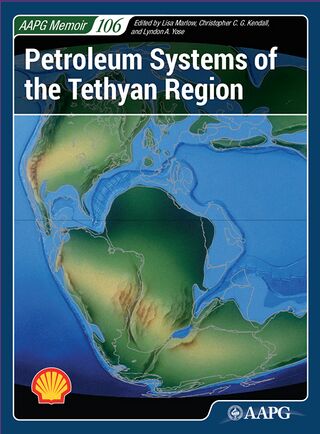
| |
| Series | AAPG Memoir |
|---|---|
| Chapter | The evolution of the Tethys region throughout the Phanerozoic: A brief tectonic reconstruction |
| Author | Fabrizio Berra, Lucia Angiolini |
| Link | Web page |
| Store | AAPG Store |
The Tethyan region is a major petroleum province. The paleogeographic position and tectonic history is a major control on sedimentation across the region, and this has influenced the sequestration of hydrocarbons in the region. The North African-Arabian plate evolved along the Tethyan margins (Proto-Tethys, Paleo-Tethys, Neo-Tethys) from Pre-Cambrian to Recent.
Paleogeographic reconstructions
Paleogeographic maps have been reconstructed for selected time intervals: Cambrian, Late Ordovician, Early Devonian, Early Permian, Permian-Triassic boundary, Norian, Callovian, Aptian, Cretaceous-Cenozoic boundary, and Late Eocene. For each time interval both the general picture of the major plate tectonic configuration and a detail of the paleogeography and paleoenvironment of North Africa to the Middle East are presented. On these maps, the major paleoenvironmental settings (from continental to shallow marine and deep ocean) are shown for the area stretching from North Africa to Afghanistan in all the selected time slices. Besides the major tectonic events, the global climate evolution and their interplay are discussed, which in some cases led to significant biotic turnovers or even to mass extinctions (e.g., Late Ordovician, Permian-Triassic boundary, Cretaceous-Cenozoic boundary). Paleogeographic maps have been compiled from literature, selecting those based on sound paleomagnetic/paleobiogeographic data. Each map is accompanied by the description of the major tectonic events that characterized the considered time interval. When contrasting paleogeographic reconstructions were available, their differences have been discussed. In general, major differences concern the interpretation of the setting and positioning of the microplates and terranes between the major continental plates.
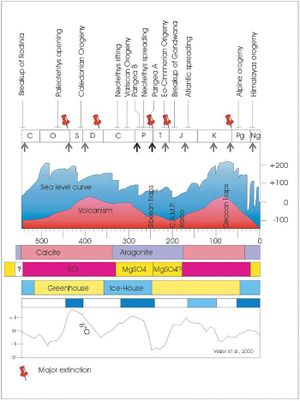
The paleogeography of the Earth during the Phanerozoic reflects the breakup of Rodinia and the formation of Pangea and its later breakup. Sedimentation was affected by the latitudinal position of the continents, the global climate conditions, and the seawater chemistry at the largest scale, and at the basin scale by the gradual changes in the local tectonic environment that accompanied the formation and destruction of the Tethyan oceans. Each global map is coupled with a more detailed map of North Africa and the Middle East. On these maps, the major depositional settings (emerged land, continental, shallow marine, and deep marine environments) are shown. These maps are a simplified view of the Western Tethys region, whereas the detailed facies distribution of the major domains is described in the chapters that follow in this book. The time-position of these paleogeographic maps is framed by the Phanerozoic history, so each map is viewed in the context of the evolution of the sea-water chemistry (aragonite vs. calcite sea, KCl vs. MgO4 evaporites), the global sea-level curve, the major volcanic events, the global climate, the major geodynamic events, and the age of the five major extinctions of the Phanerozoic (Figure 1). The interplay between these changing parameters is important as it controls and explains the distribution of climate belts (and thus the distribution of the climate-sensitive depositional environments), the depth and area of the submerged shelves, and the biogenic contribution to sediment production.
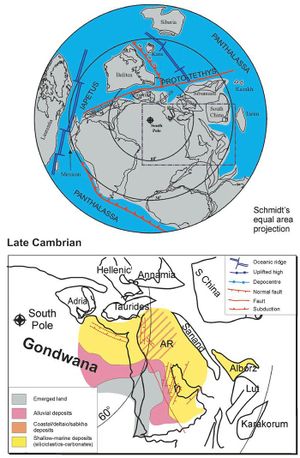
Cambrian (late Cambrian, about 500 Ma)
During Cambrian time (Figure 2) most of the continents were gathered in the southern hemisphere.[1] [3] Gondwana stretched from the equator (Australia) to the South Pole (North Africa). Tectonic movement was active mainly as a consequence of the relative rotation of the different cratons that built Gondwana.[4] Extensional tectonics that controlled the deposition of major evaporitic successions in the Arabic peninsula (Hormuz Salt Basin) and surroundings (e.g., Punjab Salt Basin) close to the Precambrian–Cambrian boundary (see dashed faults in Figure 2) came to an end, and no important tectonic activity is observed in the late Cambrian (500 Ma). Laurentia lay astride the equator in both hemispheres and was separated from Gondwana by the Iapetus Ocean. Avalonia, Armorica, Perunica, Baltica (180° geographically inverted), North and South China, and all the Cimmerian blocks fringed peripheral Gondwana at moderate to high southern latitudes. Torsvik and Cocks[3] show that South China was located close to the Equator. According to von Raumer and Stampfli,[5]d the Proto-Tethys ocean, which separated North China (to the north) from the other blocks along the peripheral Gondwana, was subducting toward the south and backarc extension, which is suggested by oceanic Cambrian seaways between the peripheral Gondwanan blocks. Torsvik and Cocks[3] recognized that their concept of the Ran Ocean used for the Cambrian-Ordovician ocean existing between Baltica and Gondwana is comparable to that of the Proto-Tethys (sensu Stampfli and Borel[2]), and herein we prefer to use the latter term. Siberia was positioned at low latitudes and was separated from Laurentia and Baltica by oceanic crust. Avalonia rifted off Gondwana in the Early Ordovician with the opening of the Rheic Ocean,[6] although some authors suggest even older ages for its opening.[3]
The scanty fossil record makes reconstruction of Cambrian paleobiogeography difficult. This fauna mostly comprises pelagic trilobites and articulated brachiopods.[1] Cocks and Torsvik[1] recognized Laurentia, Siberia, and peri-Gondwana as distinct faunal provinces. Few data are available on climate, which based on the general character of the sedimentary section was probably temperate warm to temperate cool, but arid at low latitudes. No ice seems to have been present at the poles.
Along North Africa and North Arabia, clastic continental deposits fringed a shallow water platform comprising both shales and mixed siliciclastic and carbonate facies.[7] [8]
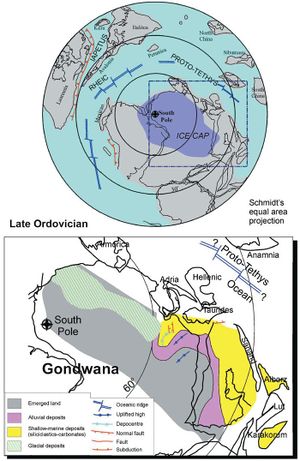
Late Ordovician (about 440 Ma)
Late Ordovician paleogeography (Figure 3) is represented by Cocks and Torsvick,[1] Robardet,[9] and Ruban et al.,[10] and shows that most continental blocks/terranes were located in the southern hemisphere except for Siberia and Tarim, which were entirely within the northern hemisphere. South China lay across the equator. The major oceans were not too large to prevent biotic exchange; thus the biota is quite cosmopolitan.
The collision of Avalonia and Baltica occurred during Late Ordovician time, as documented by paleomagnetic, tectonic, isotope, and faunal data.[1] [9] Baltica, after the accretion of Avalonia, was positioned at intermediate latitudes NW of the Northern Gondwana margin and could have deflected the South Equatorial current southward. The Iapetus Oceanic lithosphere was subducting beneath the Laurentian active margin and its width was decreasing. The Rheic Ocean was several thousands of km wide with Perunica in the northern part, having probably detached from NW Gondwana in mid-Ordovician time. According to von Raumer and Stampfli,[5] the Rheic Ocean was subducting beneath the Peri-Gondwanan blocks placed along the northern margin of Gondwana. The Panthalassic Ocean was very large and mostly covered the northern hemisphere. Cocks and Torsvik[1] suggest this ocean was comparable in size to today’s Pacific. Peri-Gondwanan blocks were located along the Gondwanan margin at high to intermediate southern latitudes. However, some faunal data (e.g., Villas et al.[11]) suggest lower latitudes, as well as the existence of peripheral blocks detaching from North Gondwana. The position and the architecture of the Armorica composite plate is still discussed (e.g., Robardet[9]). Nysæther et al.[6] suggested that by the Late Ordovician, it is possible that part of Armorica had rifted off the NW Gondwanan margin; however, Robardet[9] casted doubts on the reliability of the paleomagnetic data on which the evolution of the Armorica was based and proposed a different scenario in which the southern European blocks remained attached to the northern Gondwanan margin from Ordovician to Devonian[9] (Figure 9).
Global climate deteriorated at the end of Ordovician time, resulting in the Hirnantian glacial episode. The glaciation is documented by sedimentary evidence and isotopic data[12] and lasted about 0.5–1 million years. Peri-Gondwanan and Gondwanan glacial deposits occur in North Africa (where a N-S high was present in Egypt[13]), South America, Arabia, and South Africa, and periglacial features are known also from Armorica and Avalonia. Several interpretations have been offered on the distribution of the ice caps during the Hirnantian glaciation (a single large ice cap vs. a number of smaller ice caps), as summarized in Veevers.[4] This glaciation followed a period of climatic amelioration along the Northern Gondwana margin, evidenced by deposition of temperate bioclastic limestones and pelmatozoan-bryozoan mud-mounds, which overlie a very thick terrigenous succession of Early-Middle Ordovician age. The change from pre-Hirnantian “greenhouse” climates to Hirnantian “icehouse” conditions was rapid and was not preceded by any climatic fluctuations, which might have helped acclimatize the biota to the climate change.[12] If the pre-Hirnantian benthos was widespread in epicontinental seas and inland basins, the Hirnantian shelly fauna (e.g., Sutcliffe et al.;[14] Jin and Copper[15]) was mostly restricted to the continental margins, due to the sea-level drop caused by the glaciations in the latest Ordovician. The Hirnantian glaciation seems to have occurred during times of very high levels of the greenhouse gas CO2 (14–18 times the present atmospheric value). Brenchley et al.[12] considered that the onset of glaciation was the result of an early Hirnantian increment in burial rates of organic carbon acting as a major sink for the atmospheric CO2. However, according to Villas et al.,[11] the accumulation of great volumes of carbonates in the pre-Hirnantian late Ordovician served as the sink of the atmospheric CO2. At the end of the Hirnantian, the ice cap melting caused a rapid, eustatic sea-level rise and the development of low-oxygen conditions on the shelves.[16] [17] The end of the glaciation was followed by the deposition of organic-rich shales (Lower Silurian “hot shales”) which represent the most important source rocks in North Africa and one of the major in the Arabian peninsula.[18]
A very important event at the end of the Ordovician was the first of the Big Five Mass Extinctions[19] of the Phanerozoic, with disappearance of 85% of species, 61% of genera, and 12–24% of families.[20] The close correlation between the Ordovician extinction and the glaciation suggests climatic change as the proximate cause. However, the extinction was probably a complex event.[21] A sea-level fall and rise, changes in oceanic structure,[22] nutrient fluxes,[21] and development of anoxia[23] [24] were all ultimately related to climatic change and may have contributed to the crisis.[25]
Early Devonian (about 400 Ma)
During Early Devonian time Gondwana was centered on the Southern Pole, with northern Africa and Antarctica located toward the equator (Figure 4). The continental plates that would form future Laurasia were located immediately to the south of the equator, so that most of the continental masses were in the southern hemisphere. The Iapetus Ocean had been closed by the collision between North America and Baltica, giving rise to the Caledonian orogeny. The Avalonia Ocean between southern England and Scotland was still present, and other minor oceanic seaways separated different blocks. These blocks would later form the components of Europe, assembled during the Carboniferous Variscan orogeny, with the closure of the Rheic Ocean. The width of the Rheic Ocean is still questioned, but the paleobiogeographic distribution of different groups of fossil organisms between Laurasia and Gondwana suggests that this ocean was relatively narrow during Early Devonian.[26] The Paleo-Tethys Ocean was opening along northern Gondwana, generating a fringe of microplates (e.g., Armorica, Adria, Pontides, Hellenic, and Moesia terranes). We follow the interpretation of Torsvik and Cocks,[27] who considered Adria and Apulia as separate microplates split apart by the opening of Paleo-Tethys. The width of the Paleo-Tethys Ocean at this time is still a matter of discussion. According to Robardet et al.,[28] the detachment of Armorica from Gondwana is not older than Late Devonian, and Robardet[9] considers a fiction even the concept of an Armorica microplate. Other reconstructions[2] [27] [5] suggest that the opening of the Paleo-Tethys occurred before Early Devonian, and this is more certain for the eastward extension of this ocean.[29] Besides the strongly debated concepts of Armorica (e.g., Cocks and Torsvik,[1] Nysæther et al.,[6] Robardet,[9] Torsvik and Cocks[3]), also the relative position of the microplates detached from Gondwana with the opening of the Paleo-Tethys differs in several reconstructions: Stampfli and Borel[2] and von Raumer and Stampfli[5] identify a major continental block (Hun superterrane), whereas Torsvik and Cocks[27] suggest the presence of different independent microplates. In fact, the separation of these various microplates may have been diachronous.
Most of the Asian terranes, mainly located immediately north of the equator, were still separated by seaways before their collision with and incorporation into Pangea. The position and vergence of subduction among these blocks is not clear, and different models have been proposed (e.g., Stampfli and Borel,[2] Torsvik and Cocks,[27] Ruban et al.,[10] von Raumer and Stampfli[5]).
During Early Devonian time, a global sea-level fall was responsible for the reduction of the neritic belts. The occurrence of a wide depositional hiatus close to the Early Devonian in most of the Middle East is ascribed to this sea-level low-stand, probably enhanced by a tectonic uplift.[10]. The middle latitude position of North Africa and part of Arabia favored the development of alluvial deposits. Tectonic activity was weak and limited volcanic flows are documented[30] mainly in Sudan and in the southern area of the Eastern Desert of Egypt.[13]
Early Permian (about 290 Ma)
The late Paleozoic was a period of major plate tectonic reconfiguration (Figure 5). The Variscan orogeny led to the assembly of Gondwana and Laurasia into one supercontinent, Pangea. Adria and Apulia, previously separated, are from here onward assembled as a microplate that is referred to as Adria in the Early Permian and subsequent maps. The opening of the Neo-Tethys Ocean along the eastern margin of Gondwana, from Arabia to Australia, created the Cimmerian terranes (Iran, Central Afghanistan, Karakorum, Qiangtang). These migrated northward across the Tethys Ocean from southern Gondwanan paleolatitudes in Early Permian time to subequatorial paleolatitudes by the ~Middle Permian–Early Triassic times (e.g., Sengör[31] Dercourt et al.,[32] Besse et al.,[33] Metcalfe,[34] Muttoni et al.[35]). According to Muttoni et al.,[36] [37] [38] the Neotethyan opening is in part coeval to a major dextral motion of Laurasia relative to Gondwana that takes place essentially during Permian time. This relative motion causes the transformation of Pangea from an Early Permian configuration of the B-type, where Africa is placed south of Asia and South America is placed south of Europe,[39] [40] [41] [42] [43] [44] [45] to a Late Permian configuration of the Wegenerian A-type, where Africa is placed immediately south of Europe and South America is placed south of North America. The presence of a E-W trending trans-Pangean seaway (connecting the Paleo-Tethys to the Panthalassa oceans) persisting until the Late Permian is proposed by Vai[46] based on his interpretation of facies analyses and paleobiogeographic distribution of floral, reptile, and marine benthic organisms.
The proposed Early Permian reconstruction is from Muttoni et al.,[38] which is based on Early Permian poles that support a Pangea B configuration essentially similar to that originally proposed by Irving[39] and confirmed by subsequent analyses.[40] [41] [42] [43] [36] [37] [45] The Cimmerian terranes (alternatively named Cimmeria Superterrane) are placed close to the Gondwanan margin in Early Permian time on the basis of geological, paleontological, and paleomagnetic evidences.[47] [48] [49] [50] [38]
Neotethyan rifting along the eastern Gondwana margin from India[51] to Oman[52] started in Carboniferous times and was followed by continental breakup and formation of oceanic crust in Early Permian time (mid-Sakmarian[53] [54] [34]). In the same time interval, a major zone of northward subduction of Paleotethyan oceanic crust was active along the Eurasian margin and persisted through most of Permian–Triassic times (e.g., Dercourt et al.,[32] Alavi et al.,[55] Besse et al.,[33] Metcalfe[34]). Transpressive strike-slip tectonics was responsible for basin inversion in Lybia and Egypt.[13]
In Pennsylvanian–Early Permian times, an extensive glaciation affected much of Gondwana (e.g., Stephenson et al.,[56] Frank et al.[57]), leaving widespread glacial deposits at high to intermediate southern latitudes. The tropical belt was thus restricted to very low latitudes, which benefited from a warm westward-flowing equatorial current, which, upon reaching the continental shelves of the western Tethys Gulf, deflected southeastward, bringing warm surface waters toward the northern corner of Arabia.[45] This compressed tropical current gyre was bounded to the south by the thermal effects of the Gondwanan glacial climate, which directly controlled the distribution of cold biota in most other peri-Gondwanan terranes.
Permian-Triassic Boundary (251 Ma)
The beginning of the Mesozoic was marked by the end of the transitional stage from the Pangea B to Pangea A configurations (Irving, 1977; Morel and Irving, 1981; Muttoni et al., 1996; Torq et al., 1997; Bachtadse et al., 2002; Irving, 2005; Angiolini et al., 2007). The change in the configuration of Pangea required a west to east translation of Laurasia of some 3000 km (1864 mi) with respect to Gondwana (Figure 6). The dextral movement was accommodated along a lithospheric shear zone which runs from the subduction zone of Panthalassa eastward to a triple junction joining this shear zone, the Neo-Tethys ridge, and the subduction of Paleo-Tethys below the southern margin of Laurasia. This triple junction was located along the northern margin of the Tethys, close to southern Europe (Muttoni et al., 2009b).
Northern Gondwana was characterized by the development of a mature passive margin along the Neo-Tethys Ocean, which started to open with a time-transgressive trend beginning in Carboniferous time (Al-Belushi et al., 1996; Garzanti and Sciunnach, 1997). Oceanic crust began forming as early as Early Permian time (Garzanti, 1999; Angiolini et al., 2003; Metcalfe 2006). The opening of the Neo-Tethys was responsible for the northward flight of the peri-Gondwanan blocks: in Early Triassic time these continental blocks were moving northward toward the southern margin of Asia. These blocks include a number of minor, semi-independent blocks such as Apulia, Taurides, Iran (NW and Central), Sanandaj Sirjian, Heland, and Northern Tibet (Ruban et al., 2007). In detail, Iran was crossing the equator (Muttoni et al., 2009b) before its docking to Eurasia, which gave rise to the Cimmerian orogeny. In contrast, to the east most of the blocks were still located south of the equator. The different velocities of the peri-Gondwanan blocks were probably controlled by the presence of roughly N-S trending transform faults, which defined portions of the Neo-Tethys oceanic ridge characterized by different rates of spreading. The existence of a complex network of oceanic branches during the opening of the Neo-Tethys has been suggested by Sengor (1990), who interpreted the peri-Gondwanan blocks as three independent ribbons migrating northward.
The present-day North Africa was located along the southern passive margin of Neo-Tethys and was characterized by the development of extensional basins in Lybia and Levant (probably transtensional basins; Schandelmeier and Reynolds, 1997). Paleogeographic reconstructions are more complex in the western part of the Tethys, as the narrowing of the oceanic basin along with the closer proximity of the Neo-Tethys ridge and the Paleo-Tethys subduction zone complicate the definition and precise position of the numerous blocks which can be identified in this zone. Furthermore, the position and significance of blocks such as the Taurides and Apulia are still a matter of debate. Paleogeographic reconstructions in the western part of the Tethys Ocean are often contrasting (e.g., Dercourt et al., 2000; Stampfli and Borel, 2002). Differences can be ascribed to the puzzle of small plates and to the complex history of aperture and closure of small oceanic branches which characterize, for most of the Mesozoic, the Alpine and Dinaric domains. There are also different interpretations of the significance of the multiple extensional events along northern Gondwana, which is the most likely to represent breakup and formation of the passive margin at any particular location.
The Permian-Triassic boundary was characterized at a global scale by low sea level, reflected by widespread continental or shallow marine facies. The beginning of Triassic time was characterized by a sea-level rise that can be traced worldwide.
The end Permian crisis is generally considered the most dramatic extinction of the last 600 million years (Erwin, 2006) and led to the extinction of 75–96% of species. Some of the invoked mechanisms included rapid sea-level change and/or anoxia or euxinia (e.g., Wignall and Twitchett, 2002; Hays et al., 2007); extraterrestrial impact (e.g., Becker et al., 2001); enormous volcanic eruptions and/or an extreme global warming (e.g., Kidder and Worsley, 2004; Svensen et al., 2008; Reichow et al., 2009); or ozone layer collapse (e.g., Beerling et al., 2007). The pattern of the latest Permian extinction evaluated statistically (Jin et al., 2000; Shen et al., 2006; Groves et al., 2007; Angiolini et al., 2010) indicates that the extinction was a sudden event occurring during a sea-level rise. The evidence that the extinction was abrupt in different latest Permian paleogeographic settings is consistent with scenarios in which mass extinction resulted from climatic and environmental deterioration triggered by the Siberian Traps volcanism, which also increased greenhouse gas emissions into the atmosphere and thus global warming and ozone depletion. This is also supported by the pronounced negative δ13C excursion recorded worldwide near the latest Permian extinction event (e.g., Baud et al., 1989; Retallack and Krull, 2006; Horacek et al., 2007).
Norian (about 205 Ma)
The Norian represents a key interval in the evolution of the Paleo-Tethys Ocean (Figure 7). During this stage the first evidence for the closure of the Paleo-Tethys Ocean was recorded by the onset of the Cimmerian orogeny along the southern margin of Asia, due to the collision of the Iran blocks with the active margin of Turan. This collisional episode is known as the “Eocimmerian” event, which was followed during Jurassic time by additional collisions of other microplates (Zanchi et al., 2009).
All the microplates that detached from Gondwana were approaching Southern Asia, which was an active margin situated above a north-dipping subduction zone. The Neo-Tethys Ocean was widely open. The paleogeographic situation is clear in the central part of the Tethyan Gulf, but the geodynamic setting was extremely complex close to the triple junction located in the western part of the Tethys. Intense extensional to strike slip tectonics (likely transtension) was recorded along the southern margin of Europe, close to the future axis of the Alpine Tethys. This tectonic activity was connected westward with the Central Atlantic, where rift basins were forming during Norian time (Newark Basins). Among the different small plates in the Mediterranean region (Apulia, Greece, Turkey), minor deep-water seaways, partly floored with oceanic crust, have been recognized. Northern Africa and Arabia acted as the southern passive margin of the Neo-Tethys, with extensional basins in Lybia and Egypt (Schandelmeier and Reynolds, 1997). Extensional tectonics (Palmiryde Basin) was recorded along the Lebanon-Northern Israel shelf. Emplacement of basalts, probably related to local rifting, is documented in Israel. Intraplate alkaline magmatic activity (intrusive and subvolcanic) occurred in Sudan and S-E Egypt (Schandelmeier and Reynolds, 1997).
Frequent unconformities associated with extension along the Neotethyan margin (from Syria to Libya through Arabia) can be interpreted as far-field effects of the Cimmerian orogeny. Alternatively, they can be interpreted as local extensional events that preceded late Triassic-Liassic breakup between Apulia (sensu lato) and northern Gondwana (Robertson et al., 2003).
During Norian time, climate was generally arid at Tethyan latitudes: Carbonate facies that were deposited along the Tethys margin were bordered by evaporitic facies and coastal and continental fluvial to playa environments. Arid climate conditions probably favored the early, widespread, and pervasive dolomitization observed on most of the Norian carbonate platforms (Frisia, 1991; Iannace and Frisia, 1993). The arid belt probably extended beyond 40° latitude north and south, as reflected by the distribution of climatically sensitive facies. Climate reconstructions (Ziegler et al., 2003; Sellwood and Valdes, 2006) indicate that, during most of Triassic time, the arid belt extended to the equator, and a humid equatorial belt was probably absent. Pervasive dolomitization of carbonate platforms ended close to the Norian-Rhaetian boundary in the Western Tethys due to a shift to humid conditions (Berra et al., 2010; Berra, 2012), reflected also by the increase of siliciclastic deposits, which can be traced along part of the northern margin of the Tethys.
Callovian (about 164 Ma)
The breakup of Pangea continued in Callovian time with spreading in the Central Atlantic and the complete detachment of Africa from North America (Figure 8). A rifting event along the future axis of the North Atlantic Ocean caused the development of a network of roughly parallel rift basins along the Iberian margin and Newfoundland. Oceanic crust was also forming between India and Arabia, following an Early Jurassic rifting stage. In the Tethys area the situation was more complex (Barrier and Vrielynck, 2008), due to the existence of an extensional regime in the west (spreading in the Alpine Tethys, also known as the Penninic Ocean) and to the south (spreading in the Mesogea Ocean) and to the onset of the Neo-Tethys subduction along the southern margin of Laurasia, which followed the docking of the peri-Gondwanan blocks with Laurasia in early Middle Jurassic time (Middle Cimmerian orogeny). The northward subduction of the Neo-Tethys was responsible for the development of a volcanic belt bordering to the north the subduction zone, whereas retro-arc basins formed between the margin of Laurasia and the volcanic arc. Sedimentation in the backarc basins ranged from deep to shallow marine carbonates and clastics. The opening of the Mesogea Ocean separated the margin of Arabia and North Africa from a major continental block, composed of a large carbonate platform and related peri-platform basins, which would later form part of the Turkish jigsaw and the Dinaride-Pelagonian blocks. The southern coast of the Mesogea Ocean was marked by coastal deposits along present-day northern Africa (Guiraud and Bosworth, 1999), whereas shelf carbonates were deposited on most of the eastern to southern Arabia. The latter, bordered to the north by the Mesogea Ocean, faced to the south the new oceanic seaway, which began to separate Arabia from India. This geodynamic position, between two extensional basins, probably favored the development of deep seaways (at least partially controlled by extensional tectonics, as the Arabian Basin) on the Arabian shelf.
Aptian (about 120 Ma)
The major oceanic seaways that characterize the present-day configuration are readily recognized in the Aptian map (Figure 9). The North Atlantic Ocean was opening between Iberia and Newfoundland, whereas the northernmost part of the future Atlantic Ocean was characterized by the development of a network of rift basins seen between Canada, Greenland, and Scandinavia. Africa was separated from India and Antarctica by narrow seaways. The South Atlantic Ocean was opening between southern Africa and the southernmost part of South America. Continental South America and Africa were still connected along the future Equatorial Atlantic. The Alpine Tethys connected the Central Atlantic with the Neo-Tethys Ocean. The passive margin of North Africa and northernmost Arabia faced the Mesogea Ocean (Barrier and Vrielynck, 2008). The active southern margin of Laurasia was still characterized by the subduction of the Neo-Tethys Ocean beneath it. Along this margin it was still possible to recognize a volcanic arc with backarc basins. The central part of the Neo-Tethys was characterized by the slow northward motion of a complex puzzle of blocks, including parts of future Turkey, Greece, Dinarids, and Adria microplates. Within this block, bordered by passive margins facing to the north the Neo-Tethys Ocean and to the south the Mesogea Ocean, extensional tectonics were responsible for the development of a major basin (Pindos-Olonos basin). Albian time probably marked the beginning of the compressional regime in the Alpine Tethys, with the possible onset of its subduction. During Aptian time sea level was close to its Phanerozoic maximum, so the size of the continental shelves are very large. Along the uplifted shoulder of the southern coast of Mesogea the coastal deposits were represented by a narrow belt, whereas most of the eastern and southern part of the Arabian block were characterized by shallow to deep carbonate deposits. The future Red Sea area was uplifted and emergent, whereas in its surroundings (mainly in the present-day Libya and Egypt, where extensional basins were formed; Schandelmeier and Reynolds, 1997) fluvio-lacustrine deposits passed seaward to deltaic clastics and evaporites (Mesogea Ocean coast). Volcanic activity is recorded in Israel (alkali-basaltic lavas), whereas syenitic intrusions are reported from NE and S Sudan (Schandelmeier and Reynolds, 1997).
During Albian time the paleoceanographic setting was characterized by a major anoxic event that can be traced all across the Albian seas.
[[file:M106Ch01Fig10.jpg|thumb|300px|Figure 10
See also
References
- ↑ 1.0 1.1 1.2 1.3 1.4 1.5 1.6 1.7 1.8 Cocks, L. M. R., and Torsvik, T. K., 2002, Earth geography from 500 to 400 million years ago: A faunal and palaeomagnetic review: Journal of the Geological Society, v. 159, p. 631–644.
- ↑ 2.0 2.1 2.2 2.3 2.4 Stampfli, G. M., and Borel, G. D., 2002, A plate tectonic model for the Paleozoic and Mesozoic constrained by dynamic plate boundaries and restored synthetic oceanic isochrons: Earth and Planetary Science Letters, v. 196, p. 17–33.
- ↑ 3.0 3.1 3.2 3.3 3.4 Torsvik, T. H., and Cocks, L. R. M., 2009, The Lower Palaeozoic palaeogeographical evolution of the northeastern and eastern peri-Gondwanan margin from Turkey to New Zealand: GSL Special Publications, v. 325, p. 3–21.
- ↑ 4.0 4.1 Veevers, J. J., 2004, Gondwanaland from 650-500 Ma assembly through 320 Ma merger in Pangea to 185-100 Ma breakup: Supercontinental tectonics via stratigraphy and radiometric dating: Earth-Science Reviews, v. 68, p. 1–132.
- ↑ 5.0 5.1 5.2 5.3 5.4 von Raumer, J. F., and Stampfli, G. M., 2008, The birth of the Rheic Ocean - Early Palaeozoic subsidence patterns and subsequent tectonic plate scenarios: Tectonophysics, v. 461, p. 9–20.
- ↑ 6.0 6.1 6.2 Nysæther, E., Torvik, T. H., Feist, R., Walderhaug, H. J., and Eide, E.A., 2002, Ordovician palaeogeography with new palaeomagnetic data from the Montagne Noire (Southern France): Earth and Planetary Science Letters, v. 203, p. 329–341.
- ↑ Guiraud, R., and Bosworth, W., 1999, Phanerozoic geodynamic evolution of northeastern Africa and the northwestern Arabian platform: Tectonophysics, v. 315, p. 73–108.
- ↑ Konert, G., Abdulkader, M. A., Al-Hajri, A. A., and Droste, H. J., 2001, Paleozoic stratigraphy and hydrocarbon habitat of the Arabian Plate: GeoArabia, v. 6, p. 407–442.
- ↑ 9.0 9.1 9.2 9.3 9.4 9.5 9.6 Robardet, M., 2003, The Armorica “microplate": Fact or fiction? Critical review of the concept and contradictory palaeobiogeographical data: Palaeoeography, Palaeoclimatology, Palaeoecology, v. 195, p. 125–148.
- ↑ 10.0 10.1 10.2 Ruban, D. A., Al-Husseini, M. I., and Yumiko, I., 2007, Review of Middle East Palaeozoic plate tectonics: GeoArabia, v. 12, no. 3, p. 35–56.
- ↑ 11.0 11.1 Villas, E., Hammann, W., and Harper, D. A. T., 2002, Foliomena fauna (Brachiopoda) from the Upper Ordovician of Sardinia: Palaeontology, v. 45, p. 267–295.
- ↑ 12.0 12.1 12.2 Brenchley, P. J., Marshall, J. D., Carden, G. A. C., et al., 1994. Bathymetric and isotopic evidence for a short-lived Ordovician glaciation in a greenhouse period: Geology, v. 22, p. 295–298.
- ↑ 13.0 13.1 13.2 Schandelmeier, H. and Reynolds, P. O., eds., 1997, Palaeogeographic-palaeotectonic atlas of north-eastern Africa, Arabia, and adjacent areas: Balkema, Rotterdam, 160 p. 17 pls.
- ↑ Schandelmeier, H. and Reynolds, P. O., eds., 1997, Palaeogeographic-palaeotectonic atlas of north-eastern Africa, Arabia, and adjacent areas: Balkema, Rotterdam, 160 p. 17 pls.
- ↑ Jin, J., and Copper P., 2008, Response of brachiopod communities to environmental change during the Late Ordovian mass extinction interval, Anticosti Island, eastern Canada: Fossils and Strata, v. 54, p. 41–52.
- ↑ Rong, J.-Y., and Harper, D. A. T., 1988, A global synthesis of the latest Ordovician Hirnantian brachiopod faunas: Transactions of the Royal Society of Edinburgh Earth v. 79, p. 383–402.
- ↑ Owen, A. W., and Robertson, D. B. R., 1995, Ecological changes during the end-Ordovician extinction: Modern Geology, v. 20, p. 21–39.
- ↑ Luning, S., Craig, J., Loydell, D. K., Storch, P. B., and Fitches B., 2000, Lower Silurian ‘hot shales’ in North Africa and Arabia: Regional distribution and depositional model: Earth Science Review, v. 49, p. 121–200.
- ↑ Raup, D. M., and Sepkoski, J. J., 1982, Mass extinctions in the marine fossil record: Science, v. 215, p. 1501–1503.
- ↑ Sepkoski, J. J., 1997, Biodiversity: Past, present, and future: Journal of Paleontology, v. 71, p. 533–539.
- ↑ 21.0 21.1 Brenchley, P. J., Carden, G. A. F., and Marshall, J. D., 1995, Environmental changes associated with the “first strike” of the late Ordovician mass extinction: Modern Geology, v. 20, p. 69–82.
- ↑ Wilde, P., and Berry, W. B. N., 1984, Destabilization of the oceanic density structure and its significance to marine ‘extinction’ events: Palaeogeography, Palaeoclimatology, Palaeoecology, v. 48, p. 143–162.
- ↑ Fortey, R. A., 1989, There are extinctions and extinctions: Examples from the lower Palaeozoic. Philosophical Transactions of the Royal Society of London. Series B, v. 352, p.327–355.
- ↑ Briggs, D. E. G., Evershed, R. P., and Stankiewicz, B. A., 1998, The molecular preservation of fossil arthropod cuticles: Ancient Biomolecules, v. 2, p. 135–146.
- ↑ Brenchley, P. J., Marshall, J. D., and Underwood, C. J., 2001, Do all mass extinctions represent an ecological crisis? Evidence from the late Ordovician: Geological Journal, v. 36, p. 329–340.
- ↑ Wehrmann, A. et al., 2010, Devonian shallow-water sequences from the North Gondwana coastal margin (central and eastern Taurides, Turkey): Sedimentology, facies and global events: Gondwana Research, v. 17, p. 546–560.
- ↑ 27.0 27.1 27.2 27.3 Torsvik, T. H., and Cocks, L. R. M., 2004, Earth geography from 400 to 250 Ma: A palaeomagnetic, faunal and facies review: Journal of the GSL v. 161, p. 555–572.
- ↑ Robardet, M., Paris, F., and Racheboeuf, P. R., 1990, Palaeogeographic evolution of southwestern Europe during Early Palaeozoic times, in W. S. McKerrow and C. R. Scotese, eds., Palaeozoic palaeogeography and biogeography: GSL Memoirs 12, p. 411–419.
- ↑ Metcalfe, I., 2002, Tectonic history of the SE Asian-Australian region: Advances in Geoecology, v. 34, p. 29–48.
- ↑ Meneissy, M. Y., 1990, Vulcanicity, in R. Said, ed., The Geology of Egypt: Balkema, Rotterdam, p. 157–172.
- ↑ Sengör, A. M. C., 1979, Mid-Mesozoic closure of Permo-Triassic Tethys and its implications: Nature, v. 279, p. 590–593.
- ↑ 32.0 32.1 Dercourt, J., Ricou, L. E., and Vrielynck, B., 1993, Atlas Tethys palaeoenvironmental maps: Paris, Gauthier-Villars, p. 307.
- ↑ 33.0 33.1 Besse, J., Torcq, F., Gallet, Y., Ricou, L. E., Krystyn, L., and Saidi, A., 1998, Late Permian to Late Triassic palaeomagnetic data from Iran: Constrains on the migration of the Iranian block through the Tethyan Ocean and initial destruction of Pangea: Geophysical Journal International, v. 135, p. 77–92.
- ↑ 34.0 34.1 34.2 Metcalfe, I., 2006, Palaeozoic and Mesozoic tectonic evolution and palaeogeography of East Asian crustal fragments: The Korean Peninsula in context: Gondwana Research, v. 9, p. 24–46.
- ↑ Muttoni, G., Mattei, M., Balini, M., Zanchi, A., Gaetani, M., and Berra, F., 2009, The drift history of Iran from the Ordovician to the Triassic, in M.-F. Brunet, M. Wilmsen, and J. W. Granath, eds., South Caspian to Central Iran Basins: GSL Special Publications 312, p. 7–29.
- ↑ 36.0 36.1 Muttoni, G., Kent, D. V., Garzanti, E., Brack, P., Abrahamsen, N., and Gaetani, M., 2003, Early Permian Pangea ‘B’ to Late Permian Pangea ‘A’: Earth and Planetary Science Letters, v. 215, p. 379–394.
- ↑ 37.0 37.1 Muttoni, G., Kent, D. V., Garzanti, E., Brack, P., Abrahamsen, N., and Gaetani, M., 2004, Erratum to “Early Permian Pangea ‘B’ to Late Permian Pangea ‘A"’: Earth and Planetary Science Letters, v. 218, p. 539–540.
- ↑ 38.0 38.1 38.2 Muttoni, G., Gaetani, M., Kent, D. V., Sciunnach, D., Angiolini, L., Berra, F., Garzanti, E., Mattei, M., and Zanchi, A., 2009b, Opening of the Neo-Tethys Ocean and the Pangea B to Pangea A transformation during the Permian: GeoArabia, v. 14, no. 4, p. 17–48.
- ↑ 39.0 39.1 Irving, E., 1977, Drift of the major continental blocks since the Devonian: Nature, v. 270, p. 304–309.
- ↑ 40.0 40.1 Morel, P., and Irving, E., 1981, Paleomagnetism and the evolution of Pangea: Journal of Geophysical Research, v. 86, p. 1858–1987.
- ↑ 41.0 41.1 Muttoni, G., Kent, D. V., and Channell, J. E. T., 1996, Evolution of Pangea: Paleomagnetic constraints from the Southern Alps, Italy: Earth and Planetary Science Letters, v. 140, p. 97–112.
- ↑ 42.0 42.1 Torq, F., Besse, J., Vaslet, D., Marcoux, J., Ricou, L. E., Halawani, M., and Basahel, M., 1997, Paleomagnetic results from Saudi Arabia and the Permo-Triassic Pangea configuration: Earth and Planetary Science Letters, v. 148, p. 553–567.
- ↑ 43.0 43.1 Bachtadse, V., Zanglein, R., Tait, J., and Soffel, H., 2002, Palaeomagnetism of the Permo/Carboniferous (280 Ma) Jebel Nehoud ring complex, Kordofan, Central Sudan: Journal of African Earth Sciences, v. 35, p. 89–97.
- ↑ Irving, E., 2005, The role of latitude in mobilism debates: PNAS, v. 102, p. 1821–1828.
- ↑ 45.0 45.1 45.2 Angiolini, L., Gaetani, M., Muttoni, G., Stephenson, M. H., and Zanchi, A., 2007, Tethyan oceanic currents and climate gradients 300 m.y. ago: Geology, v. 35, p. 1071–1074.
- ↑ Vai, G. B., 2003, Development of the palaeogeography of Pangaea from Late Carboniferous to Early Permian Palaeogeography, Palaeoclimatology, v. 196, p. 125–155.
- ↑ Stöcklin, J., 1968, Structural history and tectonics of Iran: A review: AAPG Bulletin, v. 52, p. 1229–1258.
- ↑ Stöcklin, J., 1974, Possible ancient continental margins in Iran, in C. A. Burk and C. L. Drake, eds., The geology of continental margins: Springer-Verlag, p. 873–887.
- ↑ Berberian, M., and King, G., 1981, Toward a paleogeography and tectonic evolution of Iran: Canadian Journal of Earth Sciences, v. 18, p. 210–265.
- ↑ Wendt, J., Kaufmann, B., Belka, Z., Farsan, N., and Bavandpur, A. K., 2005, Devonian/Lower Carboniferous stratigraphy, facies patterns and palaeogeography of Iran Part II. Northern and central Iran: Acta Geologica Polonica, v. 55, no. 1, p. 31–97.
- ↑ Garzanti, E., and Sciunnach, D., 1997, Early Carboniferous onset of Gondwanian glaciation and Neo-Tethyan rifting in Southern Tibet: Earth Planetary Science Letters, v. 148, p. 359–365.
- ↑ Al-Belushi, J., Glennie, K. W., and Williams, B. P. J., 1996, Permo-Carboniferous glaciogenic Al Khlata Formation, Oman: A new hypothesis for origin of its glaciation: GeoArabia, v. 1, p. 389–403.
- ↑ Garzanti, E., 1999, Stratigraphy and sedimentary history of the Nepal Tethys Himalayan passive margin, in B. N. Upreti and P. Le Fort, eds., Advances on the geology of the Himalaya - focus on Nepal: Journal of Asian Earth Sciences, v. 17, p. 805–827.
- ↑ Angiolini, L., Balini, M., Garzanti, E., Nicora, A., and Tintori, A., 2003, Gondwanan deglaciation and opening of Neotethys: Palaeontological and sedimentological evidence from interior Oman: Palaeogeography, Palaeoclimatology, Palaeoecology, v. 196, p. 99–123.
- ↑ Alavi, M., Vaziri, H., Seyed Enami, K., and Lasemi, Y., 1997, The Triassic and associated rocks of the Nakhlak and Aghdarband areas in central and northeastern Iran as remnants of the southern Turanian active continental margin: GSA Bulletin, v. 109, p. 1563–1575.
- ↑ Stephenson, M. H., Angiolini, L., and Leng, M. J., 2007, The Early Permian fossil record of Gondwana and its relationship to deglaciation: A review, in M. Williams, A. Haywood, J. Gregory, and D. Schmidt, eds., Deep time perspectives on climate change: Marrying the signal from computer models and biological proxies: London, Publication of The Micropalaeontological Society, Special Publications. GSL p. 103–122.
- ↑ Frank, T. D., Birgenheier, L. P., Montañez, I. P., Fielding, C. R., and Rygel, M. C., 2008, Late Paleozoic climate dynamics revealed by comparison of ice-proximal stratigraphic and ice-distal isotopic records, in C. R. Fielding, T. D. Frank, and J. L. Isbell, eds., Resolving the late Paleozoic Ice Age in time and space: GSA Special Paper 441, p. 331–342.
